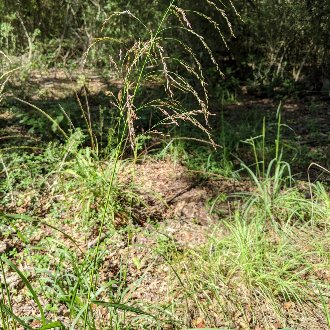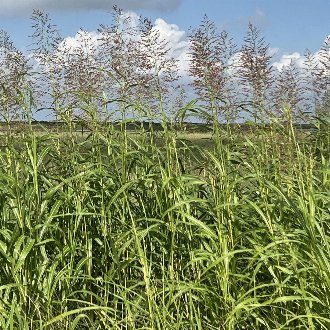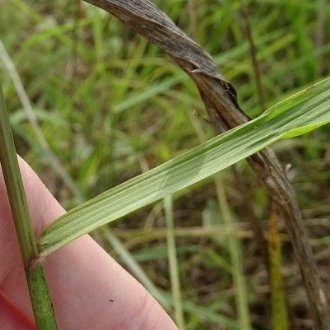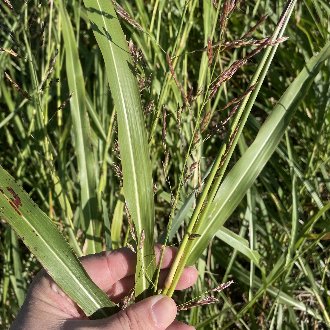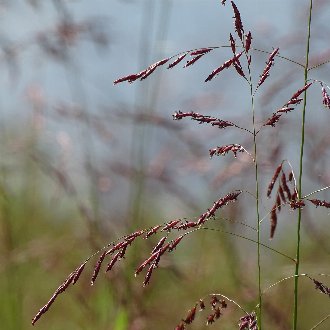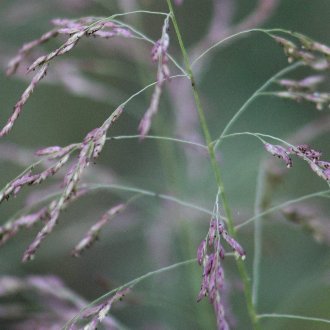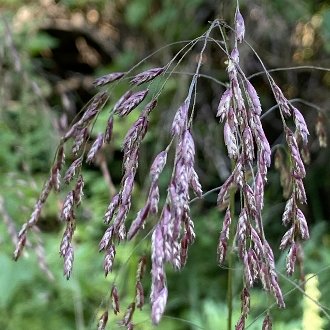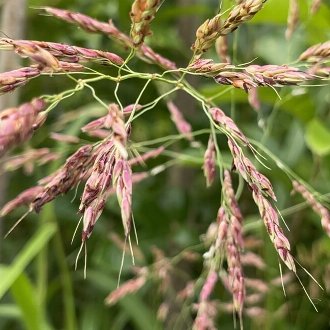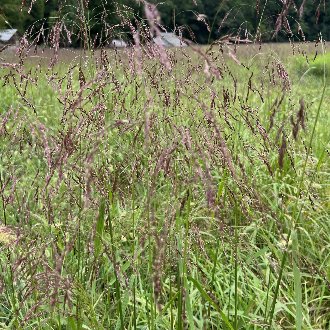Purpletop vs Johnsongrass
These two species are frequently confused where their ranges overlap. Both are perennial, warm-season grasses with purple inflorescences. They are easily distinguished by foliage, size, and details of the inflorescence. Although their habitats overlap, Johnsongrass is more restricted to moister, richer sites, and is more competetive with other vegetation, whereas purpletop ranges farther into drier sites and poorer soils and prefers less competing vegetation. Johnsongrass ranges farther west into arid climates, but their ranges in the east are similar.
Purpletop (Tridens flavus) | Johnsongrass (Sorghum halepense) |
A warm-season perennial grass native to the eastern US, found in sunny, disturbed habitats. | A perennial warm-season grass common across most of North America, considered invasive in the warmer parts of the continent. |
Plants are smaller (to 5 feet) and more delicate, with sparser, thinner foliage, and a significantly shorter maximum height. Harder to capture in a photograph because other foliage is usually visible through it. Photo © Megan Kossa, CC BY 4.0. | Plants are larger (to 7 feet) and more robust, forming thick masses of foliage at the base, and growing about 2 feet taller on average. Dense foliage often obscures other vegetation. Photo © CK Kelly, CC BY 4.0. |
Much smaller blades (3-10mm wide), either lacking a visible line down the middle, or with only a subtle line. Photo © Samantha Heller, CC BY 4.0. | Much larger blades (10-90cm long, 8-40mm wide), with bold pale line down the middle. Photo © Sam Kieschnick, CC BY 4.0. |
Lower branches of inflorescence are bare for 1/3rd to 1/2 their length. Photo © Samantha Heller, CC BY 4.0. | Lower branches of inflorescence have branches and seeds close to the base, frequently attached closer than 1/3rd the length of the whole branch. Photo © Matt Berger, CC BY 4.0. |
Branches of inflorescence may be erect, but are more likely to be nodding or drooping. Drooping is sometimes pronounced. Photo © Clay, CC BY 4.0. | Branches of inflorescence are usually erect and when they droop, they do so only slightly. Photo © stephen, CC BY 4.0. |
Mature, but not fully dried seedheads are a dark purple color. Slightly darker and slightly more bluish in hue. Photo © Sandy Wolkenberg, CC BY 4.0. | Mature, but not fully dried seedheads are a reddish-purple color. Slightly lighter and slightly more reddish in hue. Photo © Environmentalista, CC BY 4.0. |
Plants are either solitary or short-rhizomatous, at most forming a clump with multiple stems but not spreading vegetatively over long distances. Photo © ladyjanaye, CC BY 4.0. | Plants are long-rhizomatous and may form an extensive colony, vegetatively propagating over longer distances. Photo © Austin R. Kelly, CC BY 4.0. |
References & External Resources
These short lists show only links helpful for ID. For a complete list of references and resources also covering other aspects of ecology, visit the links section of the full article on each plant, which is the first entry here.



